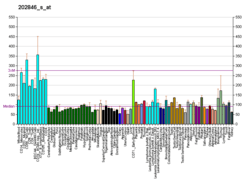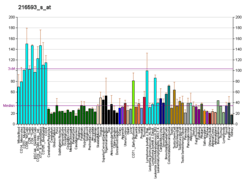PIGC
Phosphatidylinositol N-acetylglucosaminyltransferase subunit C is an enzyme that in humans is encoded by the PIGC gene.[5][6][7]
This gene encodes an endoplasmic reticulum associated protein that is involved in glycosylphosphatidylinositol (GPI) lipid anchor biosynthesis. The GPI lipid anchor is a glycolipid found on many blood cells and serves to anchor proteins to the cell surface. The encoded protein is one subunit of the GPI N-acetylglucosaminyl (GlcNAc) transferase that transfers GlcNAc to phosphatidylinositol (PI) on the cytoplasmic side of the endoplasmic reticulum. Two alternatively spliced transcripts that encode the same protein have been found for this gene. A pseudogene on chromosome 11 has also been characterized.[7]
Interactions
References
- 1 2 3 GRCh38: Ensembl release 89: ENSG00000135845 - Ensembl, May 2017
- 1 2 3 GRCm38: Ensembl release 89: ENSMUSG00000026698 - Ensembl, May 2017
- ↑ "Human PubMed Reference:".
- ↑ "Mouse PubMed Reference:".
- ↑ Inoue N, Watanabe R, Takeda J, Kinoshita T (Oct 1996). "PIG-C, one of the three human genes involved in the first step of glycosylphosphatidylinositol biosynthesis is a homologue of Saccharomyces cerevisiae GPI2". Biochem Biophys Res Commun. 226 (1): 193–9. doi:10.1006/bbrc.1996.1332. PMID 8806613.
- ↑ Hong Y, Ohishi K, Inoue N, Endo Y, Fujita T, Takeda J, Kinoshita T (Nov 1997). "Structures and chromosomal localizations of the glycosylphosphatidylinositol synthesis gene PIGC and its pseudogene PIGCP1". Genomics. 44 (3): 347–9. doi:10.1006/geno.1997.4893. PMID 9325057.
- 1 2 "Entrez Gene: PIGC phosphatidylinositol glycan anchor biosynthesis, class C".
- ↑ Watanabe, R; Inoue N; Westfall B; Taron C H; Orlean P; Takeda J; Kinoshita T (Feb 1998). "The first step of glycosylphosphatidylinositol biosynthesis is mediated by a complex of PIG-A, PIG-H, PIG-C and GPI1". EMBO J. ENGLAND. 17 (4): 877–85. doi:10.1093/emboj/17.4.877. ISSN 0261-4189. PMC 1170437. PMID 9463366.
Further reading
- Eisenhaber B, Maurer-Stroh S, Novatchkova M, et al. (2003). "Enzymes and auxiliary factors for GPI lipid anchor biosynthesis and post-translational transfer to proteins". BioEssays. 25 (4): 367–85. doi:10.1002/bies.10254. PMID 12655644.
- Adams MD, Kerlavage AR, Fleischmann RD, et al. (1995). "Initial assessment of human gene diversity and expression patterns based upon 83 million nucleotides of cDNA sequence" (PDF). Nature. 377 (6547 Suppl): 3–174. PMID 7566098.
- Watanabe R, Kinoshita T, Masaki R, et al. (1996). "PIG-A and PIG-H, which participate in glycosylphosphatidylinositol anchor biosynthesis, form a protein complex in the endoplasmic reticulum". J. Biol. Chem. 271 (43): 26868–75. doi:10.1074/jbc.271.43.26868. PMID 8900170.
- Watanabe R, Inoue N, Westfall B, et al. (1998). "The first step of glycosylphosphatidylinositol biosynthesis is mediated by a complex of PIG-A, PIG-H, PIG-C and GPI1". EMBO J. 17 (4): 877–85. doi:10.1093/emboj/17.4.877. PMC 1170437. PMID 9463366.
- Watanabe R, Murakami Y, Marmor MD, et al. (2000). "Initial enzyme for glycosylphosphatidylinositol biosynthesis requires PIG-P and is regulated by DPM2". EMBO J. 19 (16): 4402–11. doi:10.1093/emboj/19.16.4402. PMC 302040. PMID 10944123.
- Strausberg RL, Feingold EA, Grouse LH, et al. (2003). "Generation and initial analysis of more than 15,000 full-length human and mouse cDNA sequences". Proc. Natl. Acad. Sci. U.S.A. 99 (26): 16899–903. Bibcode:2002PNAS...9916899M. doi:10.1073/pnas.242603899. PMC 139241. PMID 12477932.
- Gerhard DS, Wagner L, Feingold EA, et al. (2004). "The status, quality, and expansion of the NIH full-length cDNA project: the Mammalian Gene Collection (MGC)". Genome Res. 14 (10B): 2121–7. doi:10.1101/gr.2596504. PMC 528928. PMID 15489334.
- Rual JF, Venkatesan K, Hao T, et al. (2005). "Towards a proteome-scale map of the human protein-protein interaction network". Nature. 437 (7062): 1173–8. Bibcode:2005Natur.437.1173R. doi:10.1038/nature04209. PMID 16189514.
- Gregory SG, Barlow KF, McLay KE, et al. (2006). "The DNA sequence and biological annotation of human chromosome 1". Nature. 441 (7091): 315–21. Bibcode:2006Natur.441..315G. doi:10.1038/nature04727. PMID 16710414.
This article is issued from
Wikipedia.
The text is licensed under Creative Commons - Attribution - Sharealike.
Additional terms may apply for the media files.






